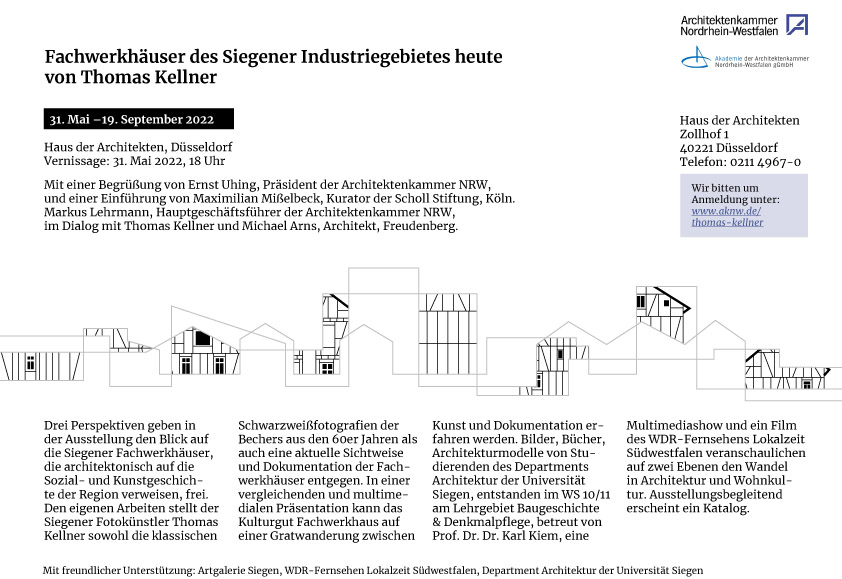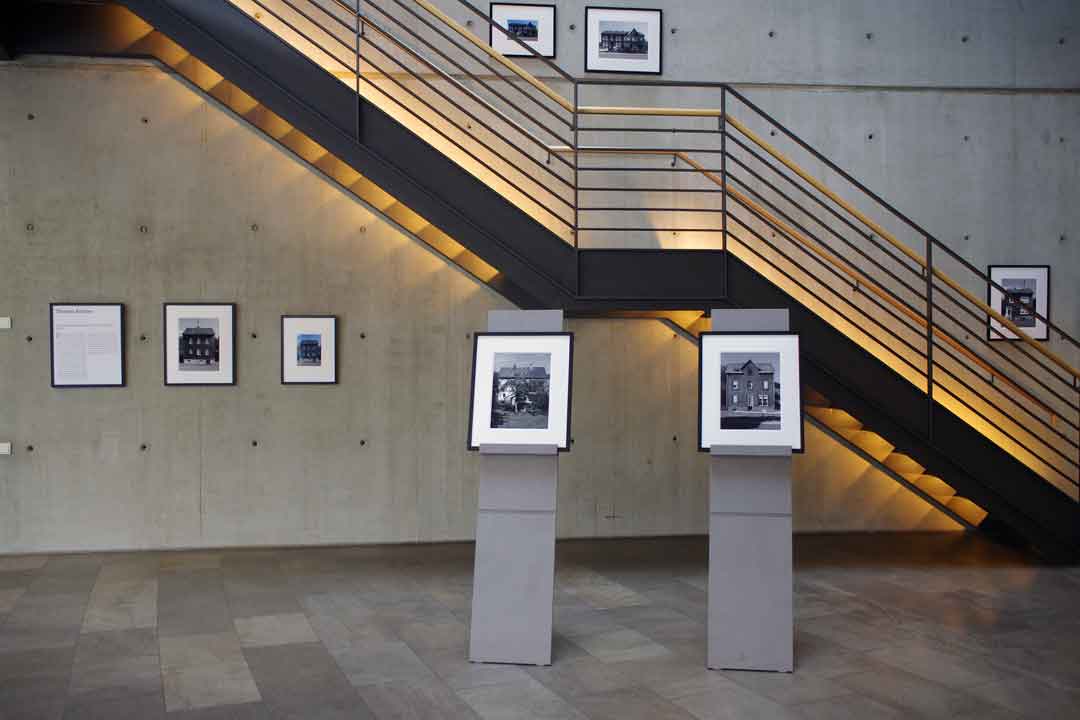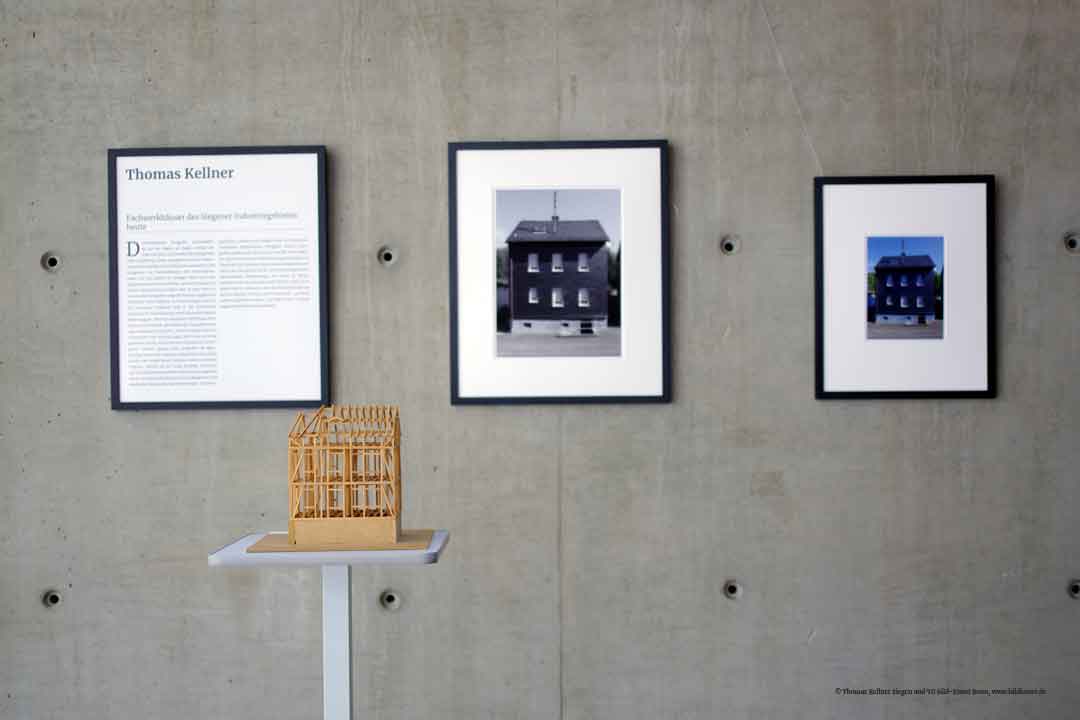Invitation
Martine Franck, the Belgian photographer, once said: "A photograph is a moment that does not return". This quote fits perfectly with the theme of the half-timbered house. Thomas Kellner has managed with his way to make a cinematic. The half-timbered houses of the photo artist are presented with a blurred background and almost no color. Despite the change in architecture, the half-timbered houses look like from another time. Magical!
Thanks to this project Thomas Kellner has won the Fresh 2021 competition: as a prize he is represented at the New York Klompching Gallery.
Currently, the Chamber of Architects of North Rhine-Westphalia exhibits the half-timbered houses of fine art photographer Thomas Kellner.

The fine art photographer
Thomas Kellner was born in 1966 in the federal city of Bonn. From 1989 to 1996 he studied economics, politics, sociology and art at the University of Siegen. Since then, he lives and works as a freelance artist in Siegen. When he was awarded the Kodak Young Artist Award in 1996, he took the plunge to become a professional artist. In the years that followed, he developed an affinity for architecture and cubism, as well as his iconic methodology of using contact sheets. His unique technique has a high recognition value, as he awakens each painting into something new with great attention to detail and imagination. Thomas Kellner has shown his work all over the world. His works are represented in important private and public collections.The Siegen-based fine art photographer is also a curator. For many years he has curated exhibitions with other fellow photographers. Until 2019, all of these exhibitions took place in his studio, followed by a presentation abroad.
The half-timbered houses through time
The half-timbered houses of Thomas Kellner, which can be seen in Düsseldorf, have a history. Between 1959 and 1978, the photographer couple Bernd and Hilla Becher photographed the half-timbered houses of the Siegerland region. For them, it was a matter of photographing threatened industrial plants, buildings and entire landscapes. A characteristic feature of the Siegerland half-timbered houses is the so-called frameless construction method. This means that as few cross braces as possible were used. In the 19th century, the region, like the Ruhr area, had developed into a main production site for iron and steel in the course of Europe-wide industrialization. Much of the demand for raw materials was earmarked for industrial purposes, so for house construction both the choice of wood and the number were allocated in limited quantities. Now half a century later, the theme of the Siegerland half-timbered house is back.
In a series of 19 architectural photographs, the artist shows selected Eiserfeld half-timbered houses in their present condition. Each of the half-timbered houses by photo artist Thomas Kellner is depicted with a blurred background. You might think that these are black and white images, but if you look closely at the pictures, you can see some color, especially around the half-timbered houses. Following the pictures of the mug, Thomas Kellner has kept their features. However, with the help of electronic image processing, the German fine art photographer managed to create a unique piece of the world for each half-timbered house.
Even though Thomas Kellner has kept the method of the mug, he adds his own magical touch. Despite this breath of fresh air that the fine art photographer brought over the half-timbered houses, they have already changed. Almost all of the 19 half-timbered houses hide their structure behind modern new walls. Time seems to pass, but actually not really. Because regardless of the change, Thomas Kellner has managed to capture the half-timbered houses in the past in their unique world of transformation. Kellner's photographs open up a view of the polarity of a building that has been altered by visual modernization measures over time and resembles the original building only in form. The subject's appraisal and condemnation of the emerging changes is as dualistic as the architectural structure itself.
The Chamber of Architects of North Rhine-Westphalia
The Chamber of Architects of North Rhine-Westphalia, located in Düsseldorf, is the largest of the 16 state chambers of architects in Germany. Abbreviated AKNW, it is the organization of professional self-government of architects, interior architects, landscape architects and urban planners in North Rhine-Westphalia. Since its foundation in 1970, it has taken the initiative in all areas of planning, building and designing the environment. Collectively, this professional association - with currently more than 30,000 members registered with the Chamber - forms the state's Chamber of Architects as a public corporation. Its headquarters is the House of Architects in Düsseldorf. The Chamber of Architects of North Rhine-Westphalia operates according to the principle of professional self-administration. This means that the members support their chamber from their own resources. All decision-making bodies are honorary and are newly elected by the members in a primary election every five years. The candidates are nominated by associations.
As Friedrich Leopold zu Stolberg-Stolberg, a German poet, wrote: "The city of Düsseldorf, a stirring place with numerous, art-loving people". Düsseldorf is the second largest city in North Rhine-Westphalia but also the capital of the state. The city is located in the center of the central European economic area. Therefore, it is a very dynamic city that offers a beautiful environment to its inhabitants. In 2018, Düsseldorf was chosen as one of the best cities in the world for its quality of life. Perhaps this is connected with the meaning of its name. Along the Düssel there are many recreational opportunities for the residents of Düsseldorf but also its residents. Those who are looking for more have the opportunity to take a walk.
The half-timbered houses of the Siegen fine art photographer Thomas Kellner are fascinating. The half-timbered houses still have a lot to show. Their unique little worlds fit in perfectly. Is it because the photo artist manages to stop time despite the architectural change of the houses? It could be that we can give a little more admiration to the half-timbered houses. Sometimes we wish that time would stop, but unfortunately this is just an illusion. This is the reason why Thomas Kellner leaves a little color to nature in his pictures, because time never stands still and brings forth new wonders.


Want to see more images? Go along here.
Contacts and contributors
Fachwerkhäuser Des Siegener Industriegebietes Heute
31st May – 19th September, 2022
AKNW Düsseldorf, Germany
Participating artist: Thomas Kellner
Architektenkammer NRW
Zollhof 1,
40221 Düsseldorf
Opening hours
Monday to Thursday from 8am to 5pm
Friday from 8am to 1pm
Telephone: +49 (0) 0211 49670
info@aknw.de
Thank you
Thank you to the AKNW and the president Ernst Uhing, the chief executive Mr. Lehrmann and the whole team of the AKNW for the exhibition.








